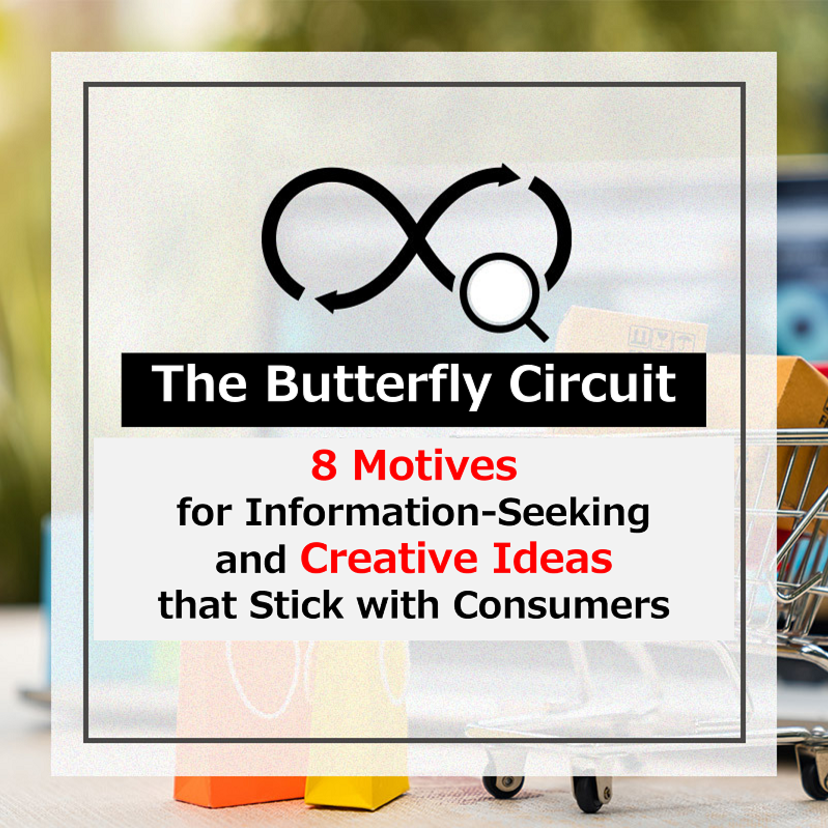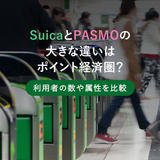The "Butterfly Circuit" represents the reality of information-seeking behavior
VALUES, Inc. Yoshiaki Saito (hereinafter "Saito"): The "Butterfly Circuit," developed in a joint research project between Google and VALUES, Inc., refers to a behavioral framework of information-seeking based on online purchasing behavior.
Conventional information-seeking models, such as "AIDMA" and "AISAS," have been based on the linear progression from brand awareness to purchase in the order of "awareness, consideration, and purchase." However, when we investigated actual information-seeking behavior based on online behavioral data, we found that information-seeking does not necessarily proceed linearly, as "Explore" to expand purchase options and "Consolidate" to narrow down the options are repeated multiple times.
On the left side the figure below, the research respondents would sometimes skip one step and return to the top step, moving back and forth between these two actions.
In addition, with the recent increase in information-seeking via smartphones, instantaneous and intuitive "impulse purchases" are on the rise. In light of this, we believe that the "Butterfly Circuit," an information-seeking behavior that wanders in circles like the movement of a butterfly, is the reality of today's information-seeking behavior.

Figure: Butterfly Circuit
Saito: This framework is based on the eight motives for this "Explore" and "Consolidate" behavior.
Saito: This framework is based on the eight motives for this "Explore" and "Consolidate" behavior.
To be more specific, the following eight motives correspond to the "Explore" behaviors that contribute to expanding a consumer's product options:
・Entertain me
・Educate me
・Brief me
・Differentiate me
And "Consolidate," which involves the process of narrowing down the options, includes the following motives:
・Assure me
・Resolve me
・Prepare me
・Encourage me
For example, when we look at the "Educate me" motive, the consumer's motivation is to gain comprehensive knowledge about something they did not know before. On the other hand, when we look at the "Prepare me" motive, a behavior for consolidating the product/service to purchase, we see that the consumer lowers their expectations so to not be disappointed after the purchase.

Figure: Eight motives that trigger information-seeking
Saito: Google also applies the "Butterfly Circuit" in a variety of settings, including in the official YouTube media materials.
A case study analyzing cosmetics purchasing behavior using the "Butterfly Circuit"
Saito: I would like to introduce a case study analyzing information-seeking behavior in purchasing cosmetics using the "Butterfly Circuit."
When we looked at the details of "Product x Butterfly Circuit," we found that the predominant movement differed by product. For example, while lipstick and lip liner are dominated by the "Explore" motive of "wanting to see a variety of the products," lotion is dominated by the "Consolidate" motive of "wanting a product that fits me." This shows the consumer mindset that "makeup is for enjoying while skincare should be reliable and secure."
Looking further at each of the eight motives, it became clear that the strength of the motive differed across "foundation," "eye shadow," and "beauty serum."

Figure: Product x Butterfly Circuit - Eight information-seeking motives by product
■How does ad creatives change the response rate for the eight information-seeking motives?
Saito: Next, when we thought about how to utilize the "Butterfly Circuit" in actual marketing activities, we hypothesized that the communication that sticks would differ depending on the consumer’s information-seeking motive.
Therefore, we created online ad creatives for a fictitious lotion and experimented with the response rate of each. We created two types of creatives.
⚫︎Creatives that exhibited functionality
⚫︎Creatives that exhibited emotion
When we asked people, "Which ads interests you more?" to better understand the different information-seeking motives, the survey showed a significant difference in response.
The creatives that exhibited functionality received a positive response from respondents who are were under the "Consolidate" context's "Prepare me" motive, and had about 2.6 times more respondents than those under the "Explore" context's "Entertain me" motive.
On the other hand, in the "creatives that exhibited emotions," the response of with the "Prepare me" motive was negative, while the response of those with the "Explore" context's "Brief me" motive and looking to expand their options was positive.

Figure: Advertising Communication x Butterfly Circuit
Saito: Based on the results of this survey, it can be assumed that preferences based on the "Explore" and "Consolidate" motivations are also occurring in advertising creatives.
Therefore, it is necessary to understand the "Butterfly Circuit" according to the eight motives of "Explore" and "Consolidate" in the promotional activities as well.
Creative development based on the "Butterfly Circuit"
Saito: In marketing, it is important to organize consumer motivations and corresponding triggers to develop effective creatives.
We would like to share how you can develop creatives for digital marketing based on the information-seeking motives of consumers captured through the "Butterfly Circuit."
Personally, the point I focus most on the "Butterfly Circuit" is how it demonstrates the consumer's movement when trying to expand their options. I'm talking about the movement from the bottom of the information-seeking staircase back to the top.
I would like to explain why we are focusing on this area, while introducing the concept of the "Construal Level Theory (Trope & Liberman)."
■"Construal Level Theory" and its challenges
Saito: The Construal Level Theory is a theory that suggests that people perceive the same object in different ways depending on their psychological distance from the object.
The figure below shows an example of the psychology of moving to a new location. (1) represents the passage of time, and (2) represents the change in location when moving, and the psychological distance caused by each.

Figure: What is the Construal Level Theory?
Saito: To be more specific, (1) demonstrates that as time passes, people begin to focus on more specific factors.
Six months before the move, the perspective was abstract, focusing on desirability, such as location and floor plan, but as the move approaches, around a month before, the focus shifts to more concrete factors, such as rent and budget.
This change of perspective is called "selection reversal."
When thinking about events that are far away from our own experiences, we tend to focus on abstract perspectives, such as the desirability of a place we have never lived, and the "grass is greener on the other side" phenomenon occurs, making it difficult to focus on concrete elements more than our current situation.
What we can say from this is that when a person's psychological distance to changes, the focus of their attention changes.
The implication of this Construal Level Theory is that when the psychological distance is small, the evaluation of secondary attributes such as "ease of use" will increase in addition to the intrinsic value (functionality, etc.) of the product.
When the distance is far, the tendency is to emphasize essential attributes, desirability, and the "why."
Nevertheless, the Construal Level Theory is not without its challenges.
The first is that it can be influenced by individual characteristics, and the second is that psychological distance is only a subjective distance, which is also a challenge for the construal level theory.
■The strength of the "Butterfly Circuit" is that it does not depend on subjectivity
Saito: On the other hand, in the "Butterfly Circuit," consumers repeatedly narrow down their choices (getting closer to the target product) and expand their choices (moving away from the target product), and this kind of behavior is considered to be less dependent on individual characteristics.
In other words, "narrowing down choices" and "expanding" are opposite "directions" of information-seeking, and the sense of distance is not plotted in a one-way journey from "far" to "near." In other words, we believe that the "Butterfly Circuit" is noteworthy in that the construal levels are easily aligned regardless of individual characteristics.

Figure: Revisiting the Butterfly Circuit in relation to the Construal Level Theory
■Characteristics of "'Consolidate' Creatives" and "'Explore' Creatives"
Saito: Based on the aforementioned, today I would like to talk about how to develop creatives that fits the motives of the "Consolidate" context and the "Explore" context.
First, let's talk about "'Consolidate' creatives."
This is a hypothesis that follows the Construal Level Theory, but with the psychological distance getting smaller, concrete appeals become more effective, and appeals about the "how" and appeals that help consumer easily evaluate the feasibility of the product/service are effective.
Let's look at "Assure me" motive as an example. In this case, in order to acknowledge consumers with this motivation, it may be effective to promote the "benefits" of the product/service to convince the consumer of the potential satisfaction in using the offering. In other words, what are the benefits of using this product or service? What kind of realization can the consumer achieve by using this product or service?

Figure: What the "Consolidate" motive seeks and the solution
Saito: Next, let's look at "'Explore' creatives" as well.
As a hypothesis in accordance with the Construal Level Theory, we can say that abstract and essential appeals are effective when the sense of psychological distance is moving farther apart, and the "why" and appeals that help easily evaluate its "desirability" are effective.
Again, let's look at the "Educate me" motive as an example.
For the "Educate me" respondents who want to gain knowledge about something they did not know about, it is necessary to provide them information that is useful for their personal interests. For example, you must provide "enlightening content," such as understanding of general knowledge, and then shine light on the consumer's "issues."

Figure: What the "Explore” motive seeks and the solution
Saito: So, what is the difference in appeals between "'Explore' creatives" and "'Consolidate' creatives"?
In the case of "'Consolidate' creatives," the subject is the product or service, while in the case of "'Explore' creatives," the subject is the consumer. The "Explore" motive is what is sought from the perspective of "people," such as wanting to know what fits their interests or what others people are choosing to buy.
Compared to "'Consolidate' creatives," "'Explore' creatives" need to be more in line with human desires and emotions.
Here, we would like to look back at the responses to the fictitious ad creatives.
When we examined the differences in response rates across the eight information-seeking motives, the results were neatly and equally split.
Creatives that exhibit emotion is more effective in terms of "Explore" motive, while creatives that are more specific in terms of functionality is more effective for the "Consolidate" motive.

Figure: Q. What kind of ad would interest you if you came across it online?
■Utilizing the "Butterfly Circuit" for both banners and landing pages
Saito: So far, I have talked about "'Consolidate' creatives" and "'Explore' creatives," but I think it is possible to organize these into "reason" and "emotion."
There is a saying that "people buy things based on emotion and are convinced by theory," and we have confirmed through online behavioral data that this cycle is repeated in a very short period of time in the digital world.
VALUES is now supporting "'Consolidate' landing pages" and "'Explore' landing pages" in addition to banner ads, but also supporting companies by focusing on what to convey as the actual destination.

Figure: Summary of suggestions from VALUES in collaboration with Google
※日本語での記事はこちらをご確認ください

「バタフライ・サーキット」が示す8つの情報探索動機と、消費者に刺さるクリエイティブとは | 日経クロストレンドフォーラム レポート
https://manamina.valuesccg.com/articles/1953Google社との共同研究で開発された、購買に至る情報探索プロセスを表すフレームワーク「バタフライ・サーキット」。2022年7月に開催された日経クロストレンドフォーラムでは、「バタフライ・サーキット」に照らし合わせた情報探索の実態と、消費者とのコミュニケーション施策への応用方法をご紹介。8つに分類した情報探索動機から、消費者に刺さるクリエイティブ施策のヒントをお届けしました。詳細なセミナー資料は無料でダウンロードできます。記事末尾のフォームよりお申し込みください。






















Born and raised in the Bay Area, U.S.A, I was fascinated by the different social and purchasing behaviors between Japanese and American consumers. I studied communication for undergrad and international marketing for my graduate studies. My professional background is in bilingual recruitment and Japanese-English translation.